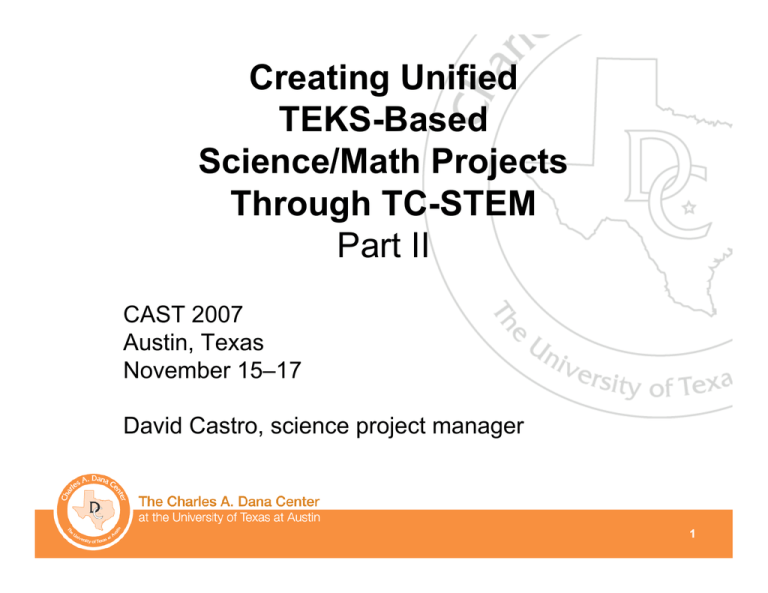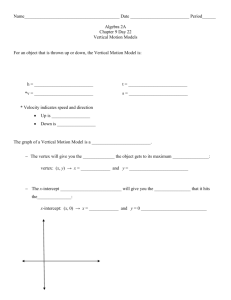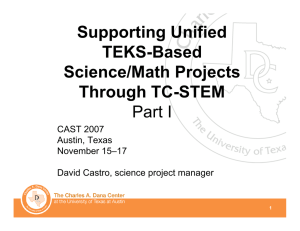Creating Unified TEKS-Based Science/Math Projects Through TC-STEM
advertisement

Creating Unified TEKS-Based Science/Math Projects Through TC-STEM Part II CAST 2007 Austin, Texas November 15–17 David Castro, science project manager 1 About the Dana Center Established during the early 1990s in the College of Natural Sciences at The University of Texas at Austin to support equity in mathematics and science education. Coordinated the development of the mathematics and science Texas Essential Knowledge and Skills. Worked long-term with over 200 school districts to support systemic change. Became a Texas Center for STEM (TC-STEM) in 2006. Provides ongoing research as well as support materials and professional development for teachers and leaders. 2 Session Objectives Discuss the advantages and challenges of implementing TEKS-based science/math projects. Define the characteristics of a successful T-STEM academy. Learn three protocols for designing TEKS-based projects. 3 Why use project-based learning? When implemented successfully, it connects to the “real world.” increases student engagement. develops problem-solving skills. promotes transfer of knowledge. builds expert understanding. is more effective than traditional instruction in supporting TEKS implementation. creates productive citizens. 4 Characteristics of a Successful T-STEM Academy The Dana Center Perspective 5 , A Successful T-STEM Academy: promotes interest in Science, Technology, Engineering, and Mathematics. provides open access to all. embraces the small-school model. provides a rich problem-solving environment. produces college-ready graduates. 6 A Successful T-STEM Academy: strongly supports implementation of the TEKS. deliberately and methodically builds student skills. promotes expert-level understanding of core content. supports teacher collaboration and professionalism. provides a guaranteed and viable curriculum. creates structures for supporting and implementing interdisciplinary project-based learning. 7 Supporting Project-Based Learning To successfully implement science/math projects, teachers must have . . . a guaranteed and viable curriculum. a common curricular vision. strong content knowledge. access to research-based pedagogy. a protocol for effective lesson design. commitment, high expectations, and accountability. leadership support. 8 Characteristics of Effective Project-Based Learning The Dana Center Perspective 9 Effective Projects … are part of a guaranteed and viable curriculum. are built around clear TEKS-based criteria. use existing resources. reinforce and extend process skills. provide opportunities for integration and skill transfer. are more effective than traditional lessons! 10 11 12 An effective curriculum must be both guaranteed and viable. Guaranteed Common understanding of the TEKS Clear student expectations Operational definition of learning outcomes Mutual accountability Viable In the available instructional time, essential content can be taught by all teachers to all students. 13 Student performance criteria transform the TEKS into guaranteed and viable curricula. 14 15 16 The Need for Vertical Articulation “Learning Line” diagram is taken from Robert J. Marzano, Debra J. Pickering, & Jane E. Pollock. (2001). Classroom Instruction that Works. Alexandria, VA: Association for Supervision and Curriculum Development, page 67. 17 The TEKS Process Skills: Grades 6–8 18 Vertically Articulated Process Skills: Grades 6–8 19 The Science–Math Bridge 20 The Science–Math Bridge: Overview Requires an investment of 3 to 4 days Integrates science and math Easy to plan Easy to implement Builds teacher and student capacity 21 The Science–Math Bridge: Calendar Day Science 1 Collect Data 2 3 Math Analyze Data Present Present 22 The Science–Math Bridge Design Protocol Collaboratively select TEKS Determine student performance criteria Select scenario Design student work products Identify necessary prior knowledge Set implementation calendar Analyze results 23 The Biology–Algebra I Bridge Collaboratively select TEKS Biology 24 The Science–Math Bridge: Biology–Geometry Determine student performance criteria 25 The Science–Math Bridge: Biology–Geometry Select scenario The scenario used in this example is based on AP Biology Free Response Question No. 2 from the 2006 released test. The graph featured in the problem depicts the effect of a newly introduced species on the populations of two other species within the same biome. Students are asked to describe the changes in population, suggest a reason for the observed changes, and predict the relative populations at a future date. Students engaged in an integrated science–math project would be asked to analyze the data either linearly (Algebra I), quadratically (Algebra II), or exponentially (Precalculus), based upon their math course. 26 The Science–Math Bridge: Biology–Geometry Design student work products, such as… – – – – – – – – posters experiments reports simulations “what if” scenarios graphs illustrations design challenges 27 The Science–Math Bridge: Biology–Geometry Identify necessary prior knowledge, such as… – – – – – – vocabulary preconceptions process skills math skills analysis tools (process) other coursework (content) In general, projects should extend prior knowledge, not introduce new content. 28 The Science–Math Bridge: Biology–Geometry Set implementation calendar that is . . . – – – – viable flexible guaranteed realistic A successful project provides structured opportunities for students to share results and create meaning. 29 The Science/Math Bridge Design Protocol Analyze results 1. 2. 3. 4. 5. Engage in collaborative reflection Analyze student work Refine and modify criteria Revise materials and activities Incorporate into district curricular documents 30 UMTA 31 UMTA (Understand, Model, Try, Apply) requires an 8-to-10-day investment emphasizes problem solving emphasizes direct experience and modeling provides a structure for building knowledge strongly supports STEM education 32 UMTA Instructional Model Understand – Two days of observation, reflection, and guided conversation Model – Two days of gathering data using real-time technology, regression analysis, and equation building (math integration) Try – Two days of carefully defined real-world problem solving Apply – Two days of open-ended real-world application 33 UMTA Instructional Model 2 Days 2 Days 4 Days Observe Collect data Confirm understanding Generalize Create a mathematical model Apply in specific contexts Affirm Test and apply model Apply in openended contexts 34 UMTA=STEM Science: Physics, Chemistry, Biology Technology: Real-time data collection Engineering: Real-world problem solving Mathematics: Mathematical modeling 35 STEM Physics: Introduction to Forces Day Lesson Title Lesson Description 1 1.1 Understanding Models Analyze scientific models for their strengths and weaknesses. 2 1.2 Forces in Equilibrium Use free body diagrams to describe the forces on single objects in equilibrium. 3 1.3 Computer Modeling 4 1.4 Frictional Forces Use Interactive Physics to construct computer models that illustrate the forces on single objects in equilibrium. Investigate how frictional forces (kinetic and static) determine the motion of single objects. 5 1.5 Modeling Friction Use Interactive Physics to model and analyze the transition between static and kinetic friction. 6 1.6 Problem Solving Student groups solve problems focusing on ’s 1st law and vector notation. 7 1.7 Project 1—“Where the Rubber Meets the Road” 8 1.8 Student Presentations—“Where the Rubber Meets the Road” Student teams design and conduct an investigation to compare the effectiveness of three different types of automobile tires. Student teams present their findings. 36 The Project-Planning Protocol (P3) 37 P3 . . . requires 7 to 10 days of science and math investment. emphasizes integration, transfer, and real-world problem solving. combines the best features of the science–math bridge and UMTA. represents STEM-based education. 38 The Alignment Issue 39 Project-Planning Protocol Day Science 1 Introduce New Content 2 Reflect 3 Gather Data Math 4 Analyze Data 5 Model Data 6 Create Design Proposal 7 Refine Design Proposal 8 Conduct Experiment 9 Analyze Analyze 10 Present Present 40 3 P Sample Project: Video Analysis of Motion Science • Physics Math • Algebra 1 • Geometry • Algebra 2 • Precalculus 41 Measuring Time A video clip plays at 30 frames each second. Δt = 1/30 s 42 Motion with Constant Speed 43 0/30 44 1/30 45 2/30 46 3/30 47 4/30 48 5/30 49 6/30 50 7/30 51 8/30 52 9/30 53 10/30 54 11/30 55 12/30 56 13/30 57 14/30 58 15/30 59 16/30 60 17/30 61 18/30 62 19/30 63 20/30 64 21/30 65 22/30 66 23/30 67 24/30 68 25/30 69 Motion Transparency 70 Motion Grid 71 Motion Axes 72 Motion Data 73 Numerical Values click 0 1 2 3 4 5 6 7 8 9 10 11 x position -5.3 -4.2 -2.5 -0.1 1.6 2.7 4.2 5.2 6.6 7.8 9.2 10.5 click 13 14 15 16 17 18 19 20 21 22 23 24 x position 13 14.2 15.5 1607 18 19.2 20.5 21.8 23 24.2 25.4 26.4 74 Using “Real” Time Units click Since each “click” is 1/30 of a second, divide each click by 30! 0 1 2 3 4 5 6 7 8 9 10 11 time (s) 0.00 0.03 0.07 0.10 0.13 0.17 0.20 0.23 0.27 0.30 0.33 0.37 75 Using “Real” Distance Units Since there are 32 squares in each meter, divide each “x” value by 32! x position x (meters) -5.3 -0.17 -4.2 -0.13 -2.5 -0.08 -0.1 0.00 1.6 0.05 2.7 0.08 4.2 0.13 5.2 0.16 6.6 0.21 7.8 0.24 9.2 0.29 10.5 0.33 76 “Real” Numerical Values t(s) 0.00 0.03 0.07 0.10 0.13 0.17 0.20 0.23 0.27 0.30 0.33 0.37 x (m) -0.17 -0.13 -0.08 0.00 0.05 0.08 0.13 0.16 0.21 0.24 0.29 0.33 t(s) x (m) 0.43 0.47 0.50 0.53 0.57 0.60 0.63 0.67 0.70 0.73 0.77 0.80 0.41 0.44 0.48 0.52 0.56 0.60 0.64 0.68 0.72 0.76 0.79 0.83 77 Graphed Data x (m) position (m) 1.00 0.50 x (m) 0.00 0.00 -0.50 0.20 0.40 0.60 0.80 1.00 time (s) 78 “Best Fit” Curve 1.00 position (m) 0.80 0.60 0.40 x (m) Linear (x (m)) 0.20 0.00 -0.200.00 0.50 1.00 -0.40 time (s) 79 Equation for the Line m = Δx/Δt = (0.8 - 0.0)/(0.75 - 0.1) = 1.23 b = -0.2 x = 1.23(t) - 0.2 80 A Closer Look at the Slope Slope = (Δx/Δt) = (Δ”m”/Δ”s”) = 1.23 m/s = speed Note that the slope and, therefore, the speed, is constant! 81 Tennis Ball Drop Given: – Each frame is 1/30 second. – Grid squares are 10 cm x 10 cm. Task: – Plot and run regression analysis of position vs. time and velocity vs. time. 82 0/30 83 1/30 84 2/30 85 3/30 86 4/30 87 5/30 88 6/30 89 7/30 90 Sample Position vs. Time 2 0 -2 -4 0 2 4 6 8 distance Poly. (distance) -6 -8 -10 91 Sample Velocity vs. Time 0 -0.5 0 2 4 6 -1 -1.5 velocity Linear (velocity) -2 -2.5 -3 92 Dropped Water Balloon Given: – The balloon contains 10g of water. – Each frame is 1/30 second. – Grid squares are 10 cm x 10 cm. Task: – Plot and run regression analysis of position vs. time and velocity vs. time. 93 0/30 94 1/30 95 2/30 96 3/30 97 4/30 98 5/30 99 6/30 100 7/30 101 8/30 102 9/30 103 10/30 104 11/30 105 Sample Position of the Water Balloon 0 -2 0 2 4 6 8 10 -4 -6 -8 -10 Position Poly. (Position) -12 -14 -16 106 Sample Velocity of the Water Balloon 0 -0.5 0 2 4 6 8 10 -1 -1.5 Velocity Poly. (Velocity) -2 -2.5 -3 107 Comparison of Ball and Balloon Sample Velocity vs. Time 0 -0.5 0 2 4 6 -1 -1.5 velocity Linear (velocity) -2 -2.5 -3 Sample Velocity of theWater Balloon 0 -0.5 0 2 4 6 8 10 -1 -1.5 Velocity Poly. (Velocity) -2 -2.5 -3 108 Contact information David Castro, science project manager davidcastro@mail.utexas.edu www.sciencetekstoolkit.org www.utdanacenter.org 109




